Abstract
OBJECTIVE: To examine the relation between serum urate and the risk of major coronary heart disease events. DESIGN: A prospective study of a male cohort. SETTING: One general practice in each of 24 British towns. SUBJECTS: 7688 men aged 40-59 years at screening. MAIN OUTCOME MEASURES: Fatal and non-fatal coronary heart disease events. RESULTS: There were 1085 major coronary heart disease events during the average follow up period of 16.8 years. Serum urate was significantly associated with a wide range of cardiovascular risk factors including body mass index, alcohol intake, antihypertensive treatment, pre-existing coronary heart disease, serum triglycerides, cholesterol, and diastolic blood pressure. There was a significant positive association between serum urate and risk of coronary heart disease after adjustment for lifestyle factors and disease indicators. This relation was attenuated to non-significance upon additional adjustment for diastolic blood pressure and serum total cholesterol: cholesterol appeared to be the critical factor in attenuating this relation. When the association between serum urate and risk of coronary heart disease was examined by presence and grade of pre-existing coronary heart disease, a positive association was seen only in men with previous definite myocardial infarction, even after full adjustment (P = 0.07). CONCLUSIONS: The relation between serum urate and the risk of coronary heart disease depends heavily upon the presence of pre-existing myocardial infarction and widespread underlying atherosclerosis as well as the clustering of risk factors. Thus serum urate is not a truly independent risk factor for coronary heart disease. Raised serum urate appears to be an integral part of the cluster of risk factors associated with the insulin resistance syndrome that include obesity, raised serum triglycerides, and serum cholesterol.
Full text
PDF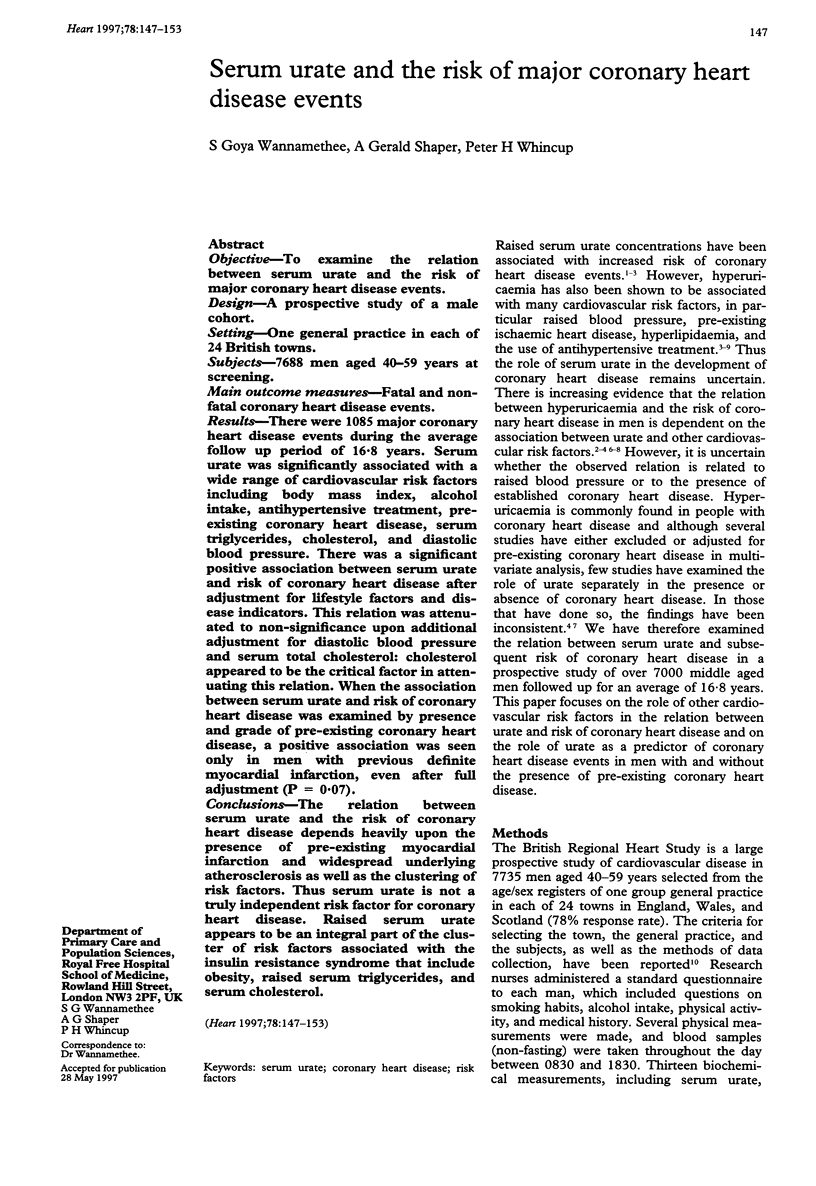
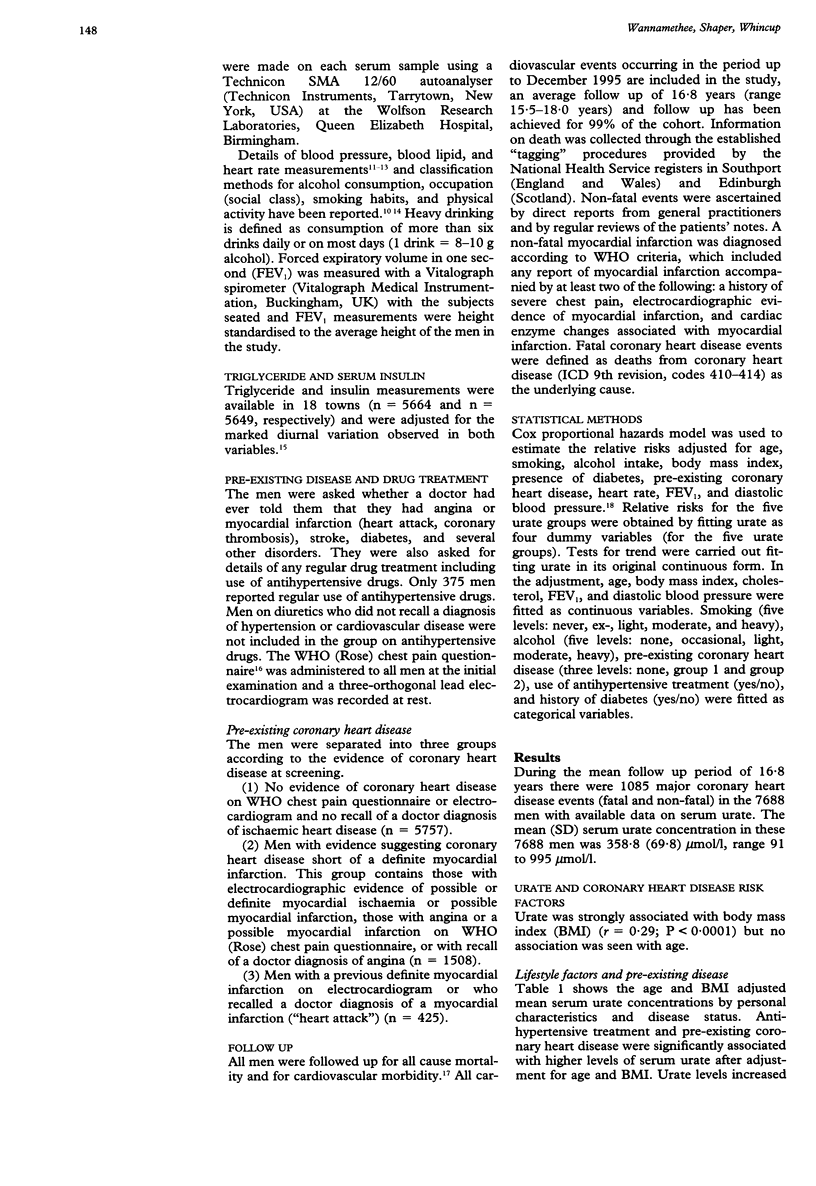

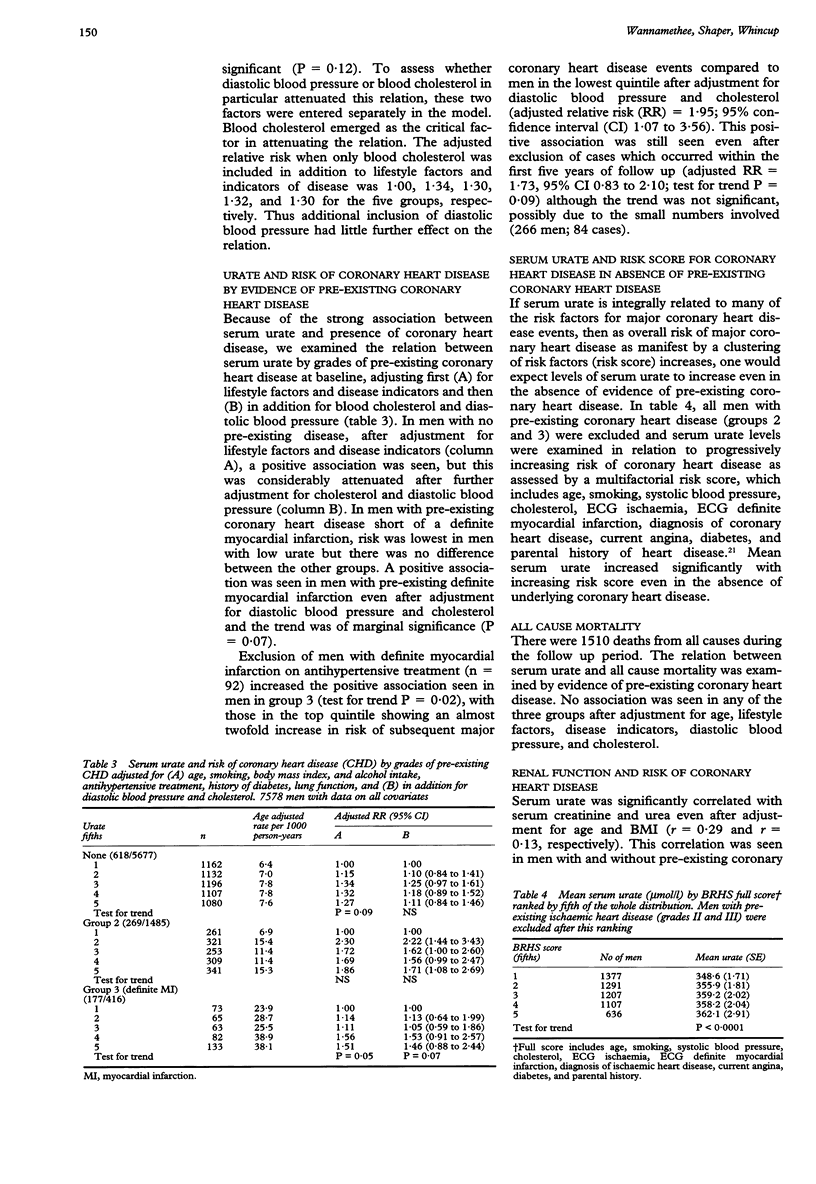
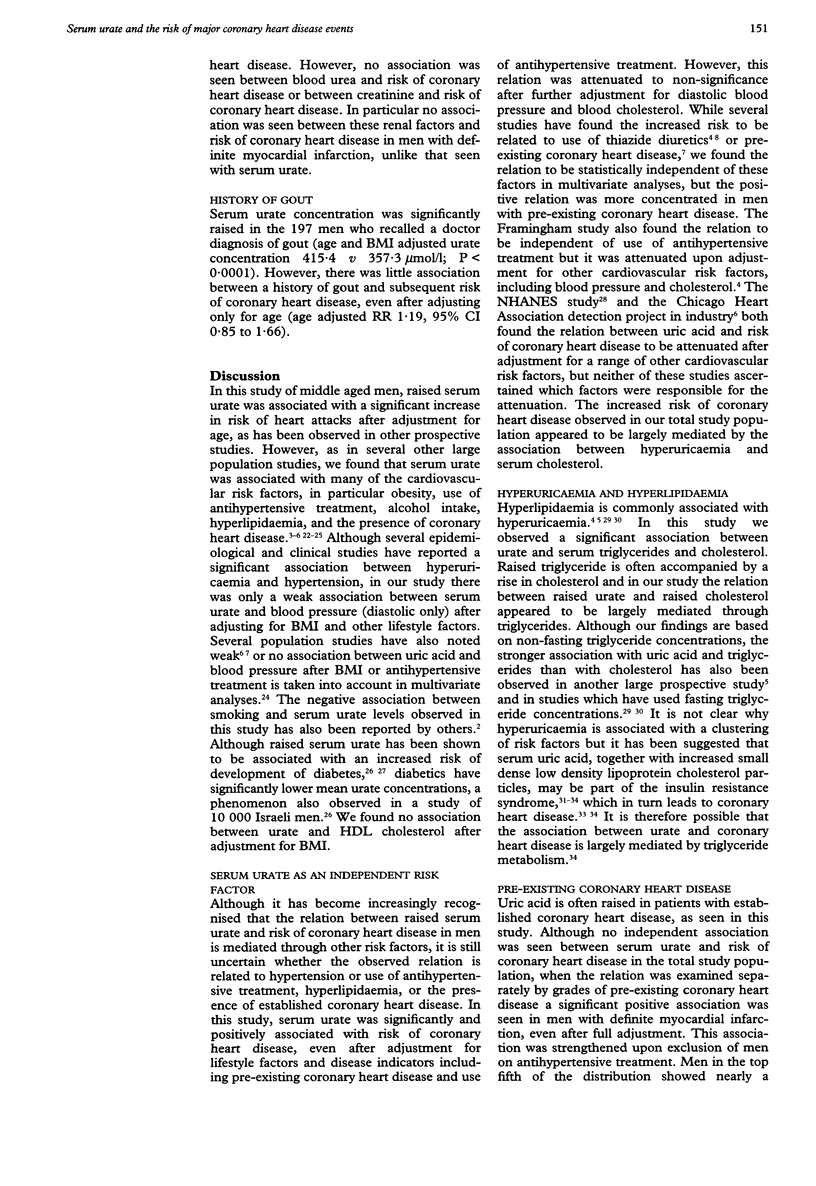
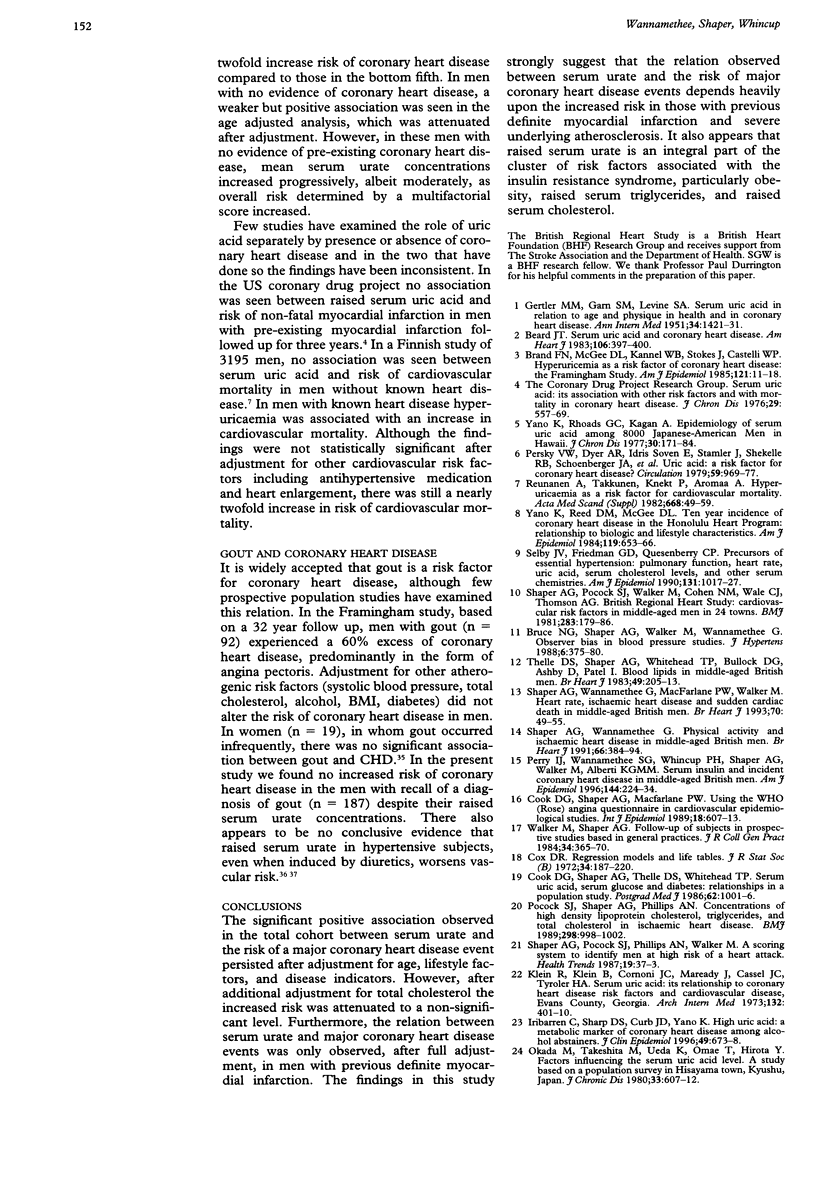
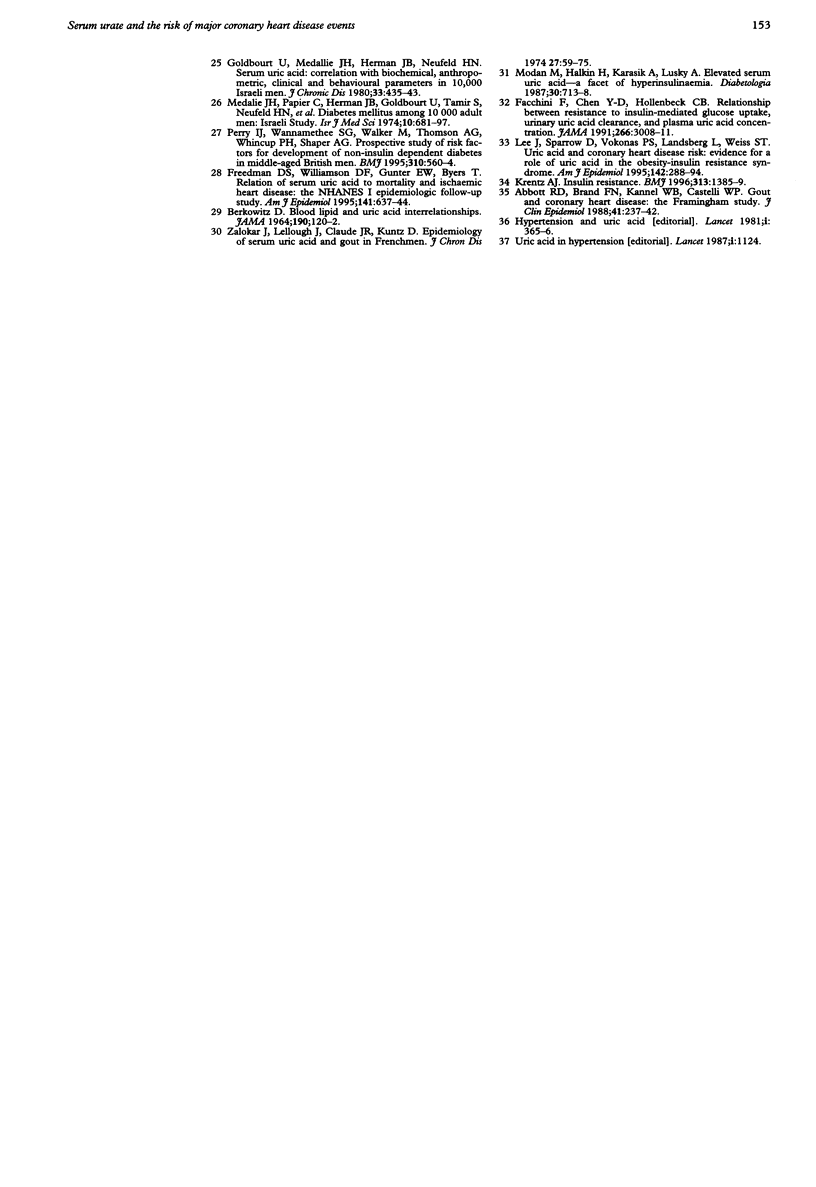
Selected References
These references are in PubMed. This may not be the complete list of references from this article.
- Abbott R. D., Brand F. N., Kannel W. B., Castelli W. P. Gout and coronary heart disease: the Framingham Study. J Clin Epidemiol. 1988;41(3):237–242. doi: 10.1016/0895-4356(88)90127-8. [DOI] [PubMed] [Google Scholar]
- Beard J. T., 2nd Serum uric acid and coronary heart disease. Am Heart J. 1983 Aug;106(2):397–400. doi: 10.1016/0002-8703(83)90209-0. [DOI] [PubMed] [Google Scholar]
- Brand F. N., McGee D. L., Kannel W. B., Stokes J., 3rd, Castelli W. P. Hyperuricemia as a risk factor of coronary heart disease: The Framingham Study. Am J Epidemiol. 1985 Jan;121(1):11–18. doi: 10.1093/oxfordjournals.aje.a113972. [DOI] [PubMed] [Google Scholar]
- Bruce N. G., Shaper A. G., Walker M., Wannamethee G. Observer bias in blood pressure studies. J Hypertens. 1988 May;6(5):375–380. [PubMed] [Google Scholar]
- Cook D. G., Shaper A. G., MacFarlane P. W. Using the WHO (Rose) angina questionnaire in cardiovascular epidemiology. Int J Epidemiol. 1989 Sep;18(3):607–613. doi: 10.1093/ije/18.3.607. [DOI] [PubMed] [Google Scholar]
- Cook D. G., Shaper A. G., Thelle D. S., Whitehead T. P. Serum uric acid, serum glucose and diabetes: relationships in a population study. Postgrad Med J. 1986 Nov;62(733):1001–1006. doi: 10.1136/pgmj.62.733.1001. [DOI] [PMC free article] [PubMed] [Google Scholar]
- Facchini F., Chen Y. D., Hollenbeck C. B., Reaven G. M. Relationship between resistance to insulin-mediated glucose uptake, urinary uric acid clearance, and plasma uric acid concentration. JAMA. 1991 Dec 4;266(21):3008–3011. [PubMed] [Google Scholar]
- Freedman D. S., Williamson D. F., Gunter E. W., Byers T. Relation of serum uric acid to mortality and ischemic heart disease. The NHANES I Epidemiologic Follow-up Study. Am J Epidemiol. 1995 Apr 1;141(7):637–644. doi: 10.1093/oxfordjournals.aje.a117479. [DOI] [PubMed] [Google Scholar]
- GERTLER M. M., GARN S. M., LEVINE S. A. Serum uric acid in relation to age and physique in health and in coronary heart disease. Ann Intern Med. 1951 Jun;34(6):1421–1431. doi: 10.7326/0003-4819-34-6-1421. [DOI] [PubMed] [Google Scholar]
- Goldbourt U., Medalie J. H., Herman J. B., Neufeld H. N. Serum uric acid: correlation with biochemical, anthropometric, clinical and behavioral parameters in 10,000 Israeli men. J Chronic Dis. 1980;33(7):435–443. doi: 10.1016/0021-9681(80)90040-5. [DOI] [PubMed] [Google Scholar]
- Iribarren C., Sharp D. S., Curb J. D., Yano K. High uric acid: a metabolic marker of coronary heart disease among alcohol abstainers. J Clin Epidemiol. 1996 Jun;49(6):673–678. doi: 10.1016/0895-4356(96)00034-0. [DOI] [PubMed] [Google Scholar]
- Krentz A. J. Insulin resistance. BMJ. 1996 Nov 30;313(7069):1385–1389. doi: 10.1136/bmj.313.7069.1385. [DOI] [PMC free article] [PubMed] [Google Scholar]
- Lee J., Sparrow D., Vokonas P. S., Landsberg L., Weiss S. T. Uric acid and coronary heart disease risk: evidence for a role of uric acid in the obesity-insulin resistance syndrome. The Normative Aging Study. Am J Epidemiol. 1995 Aug 1;142(3):288–294. doi: 10.1093/oxfordjournals.aje.a117634. [DOI] [PubMed] [Google Scholar]
- Medalie J. H., Papier C., Herman J. B., Goldbourt U., Tamir S., Neufeld H. N., Riss E. Diabetes mellitus among 10,000 adult men. I. Five-year incidence and associated variables. Isr J Med Sci. 1974 Jul;10(7):681–697. [PubMed] [Google Scholar]
- Modan M., Halkin H., Karasik A., Lusky A. Elevated serum uric acid--a facet of hyperinsulinaemia. Diabetologia. 1987 Sep;30(9):713–718. doi: 10.1007/BF00296994. [DOI] [PubMed] [Google Scholar]
- Okada M., Takeshita M., Ueda K., Omae T., Hirota Y. Factors influencing the serum uric acid level. A study based on a population survey in Hisayama town, Kyushu, Japan. J Chronic Dis. 1980;33(10):607–612. doi: 10.1016/0021-9681(80)90003-x. [DOI] [PubMed] [Google Scholar]
- Perry I. J., Wannamethee S. G., Walker M. K., Thomson A. G., Whincup P. H., Shaper A. G. Prospective study of risk factors for development of non-insulin dependent diabetes in middle aged British men. BMJ. 1995 Mar 4;310(6979):560–564. doi: 10.1136/bmj.310.6979.560. [DOI] [PMC free article] [PubMed] [Google Scholar]
- Perry I. J., Wannamethee S. G., Whincup P. H., Shaper A. G., Walker M. K., Alberti K. G. Serum insulin and incident coronary heart disease in middle-aged British men. Am J Epidemiol. 1996 Aug 1;144(3):224–234. doi: 10.1093/oxfordjournals.aje.a008917. [DOI] [PubMed] [Google Scholar]
- Persky V. W., Dyer A. R., Idris-Soven E., Stamler J., Shekelle R. B., Schoenberger J. A., Berkson D. M., Lindberg H. A. Uric acid: a risk factor for coronary heart disease? Circulation. 1979 May;59(5):969–977. doi: 10.1161/01.cir.59.5.969. [DOI] [PubMed] [Google Scholar]
- Pocock S. J., Shaper A. G., Phillips A. N. Concentrations of high density lipoprotein cholesterol, triglycerides, and total cholesterol in ischaemic heart disease. BMJ. 1989 Apr 15;298(6679):998–1002. doi: 10.1136/bmj.298.6679.998. [DOI] [PMC free article] [PubMed] [Google Scholar]
- Reunanen A., Takkunen H., Knekt P., Aromaa A. Hyperuricemia as a risk factor for cardiovascular mortality. Acta Med Scand Suppl. 1982;668:49–59. doi: 10.1111/j.0954-6820.1982.tb08521.x. [DOI] [PubMed] [Google Scholar]
- Selby J. V., Friedman G. D., Quesenberry C. P., Jr Precursors of essential hypertension: pulmonary function, heart rate, uric acid, serum cholesterol, and other serum chemistries. Am J Epidemiol. 1990 Jun;131(6):1017–1027. doi: 10.1093/oxfordjournals.aje.a115593. [DOI] [PubMed] [Google Scholar]
- Shaper A. G., Pocock S. J., Phillips A. N., Walker M. A scoring system to identify men at high risk of a heart attack. Health Trends. 1987 May;19(2):37–39. [PubMed] [Google Scholar]
- Shaper A. G., Pocock S. J., Walker M., Cohen N. M., Wale C. J., Thomson A. G. British Regional Heart Study: cardiovascular risk factors in middle-aged men in 24 towns. Br Med J (Clin Res Ed) 1981 Jul 18;283(6285):179–186. doi: 10.1136/bmj.283.6285.179. [DOI] [PMC free article] [PubMed] [Google Scholar]
- Shaper A. G., Wannamethee G., Macfarlane P. W., Walker M. Heart rate, ischaemic heart disease, and sudden cardiac death in middle-aged British men. Br Heart J. 1993 Jul;70(1):49–55. doi: 10.1136/hrt.70.1.49. [DOI] [PMC free article] [PubMed] [Google Scholar]
- Shaper A. G., Wannamethee G., Weatherall R. Physical activity and ischaemic heart disease in middle-aged British men. Br Heart J. 1991 Nov;66(5):384–394. doi: 10.1136/hrt.66.5.384. [DOI] [PMC free article] [PubMed] [Google Scholar]
- Thelle D. S., Shaper A. G., Whitehead T. P., Bullock D. G., Ashby D., Patel I. Blood lipids in middle-aged British men. Br Heart J. 1983 Mar;49(3):205–213. doi: 10.1136/hrt.49.3.205. [DOI] [PMC free article] [PubMed] [Google Scholar]
- Walker M., Shaper A. G. Follow-up of subjects in prospective studies based in general practice. J R Coll Gen Pract. 1984 Jul;34(264):365–370. [PMC free article] [PubMed] [Google Scholar]
- Yano K., Reed D. M., McGee D. L. Ten-year incidence of coronary heart disease in the Honolulu Heart Program. Relationship to biologic and lifestyle characteristics. Am J Epidemiol. 1984 May;119(5):653–666. doi: 10.1093/oxfordjournals.aje.a113787. [DOI] [PubMed] [Google Scholar]
- Yano K., Rhoads G., Kagan A. Epidemiology of serum uric acid among 8000 Japanese-American men in Hawaii. J Chronic Dis. 1977 Mar;30(3):171–184. doi: 10.1016/0021-9681(77)90083-2. [DOI] [PubMed] [Google Scholar]
- Zalokar J., Lellouch J., Claude J. R., Kuntz D. Epidemiology of serum uric acid and gout in Frenchmen. J Chronic Dis. 1974 Feb;27(1):59–75. doi: 10.1016/0021-9681(74)90008-3. [DOI] [PubMed] [Google Scholar]


